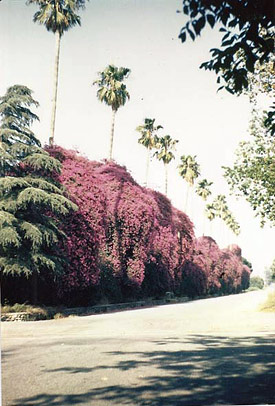
Glendora, California
Glendora Bougainvillea 
Courtesy Katharine Rudnyk
history continued
Hamlin, with the guidance of his wife, planted the Bougainvillea vines next to a row of twenty-five palm trees (Washington robusta), creating a colorful purple-fuchsia accent to the tall, slender, and elegant palm trunks. The plantings bordered the Hamlin's orange grove along the streets now known as Bennett and Minnesota Avenues. The palm trees and adjacent Bougainvillea were irrigated and fertilized as part of the orange grove, leading to rapid growth. To prevent soil erosion, a cobblestone retaining wall was constructed around the plantings in 1912 that used indigenous stones from the nearby San Gabriel River. During this time, such walls were typical features of area groves; today, they are rare survivors.
By 1927, the Glendora Bougainvillea had become a tourist attraction – serving as “sirens” of California’s booster period. The plantings reportedly appeared in postcards for the town and made cameo appearances in early movies promoting the lure of California life. As K.D. Kurutz and Gary F. Kurutz suggest in California Calls You: The Act of Promoting the Golden State: 1870-1940, features such as the Glendora Bougainvillea equated to “symbols that expanded the imagination and the dreams of opportunity.”
In 1929, the Hamlins sold the citrus ranch. In the 1940s, Dr. Lloyd J. and Mrs. Doris W. Pittman owned the property, at which time, the Glendora Bougainvillea, as they had come to be known, stood between fifty and seventy-five feet high and formed a column twelve to twenty feet in diameter around the base of the ninety-foot palm trees.